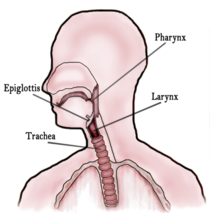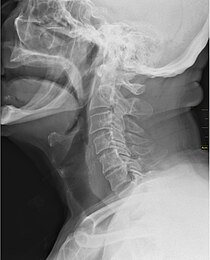Throat
| Throat | |
|---|---|
 The human throat | |
 X-ray showing the throat, seen as a dark band to the front of the spine | |
| Details | |
| Identifiers | |
| Latin | gula jugulum |
| FMA | 228738 |
| Anatomical terminology | |
In
palatine uvula, the trachea, the esophagus, and the vocal cords.[1][2] Mammal throats consist of two bones, the hyoid bone and the clavicle. The "throat" is sometimes thought to be synonymous for the fauces.[3]
It works with the mouth,
bronchi of the lungs. The esophagus carries food through the throat to the stomach.[5] Adenoids and tonsils help prevent infection and are composed of lymph tissue. The larynx contains vocal cords, the epiglottis (preventing food/liquid inhalation), and an area known as the subglottic larynx, in children it is the narrowest section of the upper part of the throat.[6][7]
The jugulum is a low part of the throat, located slightly above the breast.[8] The term jugulum is reflected both by the internal and external jugular veins, which pass through the jugulum.
References
- ^ "pharynx | Definition, Location, Function, Structure, & Facts". Encyclopedia Britannica. Retrieved 2020-09-01.
- ^ "Larynx | anatomy". Encyclopedia Britannica. Retrieved 2020-09-01.
- ^ "throat" at Dorland's Medical Dictionary
- ^ "eustachian tube | Definition, Anatomy, & Function". Encyclopedia Britannica. Retrieved 2020-09-01.
- ^ "Esophagus | anatomy". Encyclopedia Britannica. Retrieved 2020-09-01.
- ^ "Throat anatomy and physiology". Children's Hospital of Philadelphia. 5 May 2014. Retrieved 7 August 2015.
- ^ "Laryngeal Stenosis: Background, Problem, Epidemiology". 2020-02-19.
{{cite journal}}: Cite journal requires|journal=(help) - ^ Farlex dictionary, citing: Webster's Revised Unabridged Dictionary, published 1913 by C. & G. Merriam Co.
See also
Look up throat in Wiktionary, the free dictionary.
Look up jugular in Wiktionary, the free dictionary.
- Strep throat
- Tonsilloliths
- Tracheotomy
